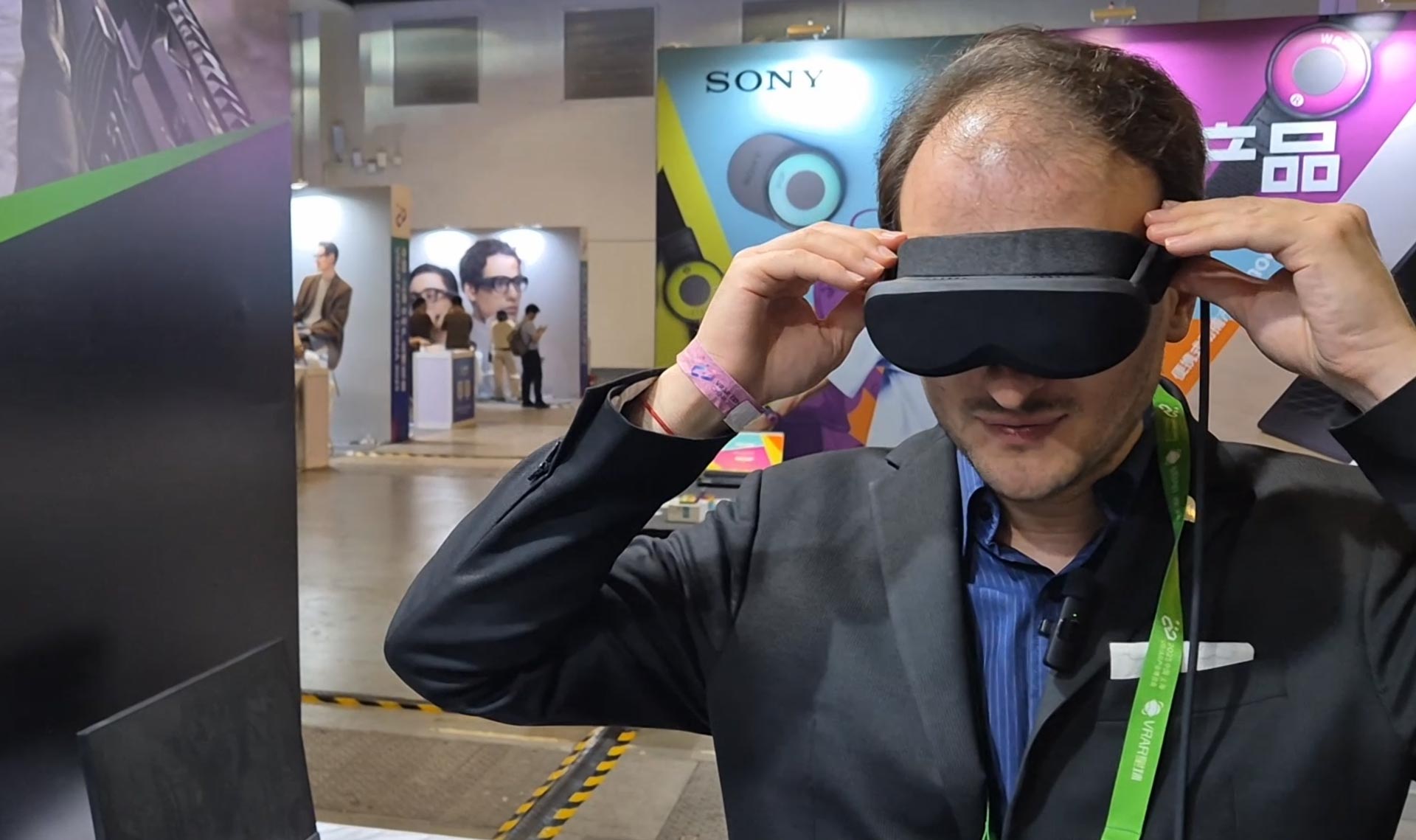Pimax Dream Air preview: a promising headset
At the VR AR Expo China, I had the exclusive opportunity to look at the current iteration of the Pimax Dream Air, the high-resolution ultra-lightweight headset that Pimax is going to launch in the next months.
Pimax Dream Air
The Pimax Dream Air is a new type of headset that Pimax has decided to launch. While the company has become famous for very bulky headsets able to deliver a high resolution paired with a wide field of view, with the Pimax Dream Air, it is aiming at a tiny and lightweight device, still able to deliver a very high definition.
The Dream Air is supposed to have the following specifications:
- Display Type: Micro-OLED
- Resolution: 3840 x 3552 pixels per eye
- FOV: 102° FOV(H)
- Refresh Rate: 90 Hz
- Weight: less than 200 grams
- Fit mechanism: self-adjusting strap
- Tracking: inside-out, with support for Lighthouses
- Eye Tracking: supported
The headset is supposed to have a very high resolution, a quite ok FOV, and great comfort, thanks to the small size of the device.
Price and release date
The headset is expected to be available in Q3 2025. Pimax told me that the Pimax Dream Air SE is coming before the Dream Air, and that the version with Lighthouse tracking is going to be available before the one with inside-out tracking.
The expected price is, as usual, confusing, in clear Pimax Style: the total is €1,851-2,144, to be calculated this way:
- Lighthouse version: Upfront Payment €1169 + Prime Fee €682
- SLAM version: Upfront Payment €1364 + Prime Fee €780
Hands-on Pimax Dream Air
Pimax Dream Air is going to be released in a few months, and of course, it is not complete yet. At the event in China, I’ve been able to try the current iteration of the device, which, of course, is not finalized, so it misses some of the features and is rough around the edges on almost everything. My test can’t be an evaluation of the final device, but it can help in understanding what is the current status of the product and see if Pimax is on the right path to deliver a good headset.
Comfort and Design
The device I was given looked like a rough prototype. It seemed 3D printed in some parts, totally not adherent to the final design in others, plus it had probably been used many times, so some parts of it (like the facemask) didn’t seem to be in great condition. It is very hard to evaluate the final design of the product in these conditions. Let me show anyway some photos I took of it.




The only thing I can comment upon is the size and the weight: the headset is very small (more or less as competitors like the BigScreen Beyond and the Shiftall MeganeX Superlight) and very lightweight. Since it is very light, it fits very comfortably on the face, and you barely feel it if compared to the competition. It does not feel like a shoebox on the face, but like big glasses. Even if I did not have a top strap, I did not feel the need for it, because the back strap sufficed to keep the headset on my head. Compared to the MeganeX, this headset features a standard fitting mechanism with fewer possible customizations. This makes the Pimax Dream Air less customizable, but for sure easier to set up.
The only uncomfortable thing about the demo was the cable that connects the headset to the PC. Since the headset is very small and the cable is pretty big, the cable that is on the left side, when it moves, risks moving the whole device on your face. That’s why in the final version, the full headset cable will be split into two, with one cable going to the left side and one to the right side. This way, the cable does not imbalance the device on just one side.

I would be very curious to try the auto-fitting mechanism that Pimax is working on… but at the moment, they have only a standard elastic on the back… and even one that, after many use,s is not that elastic anymore…
Visuals
The clarity of this headset is staggering: 4K per eye is a lot, and I could see very crisp visuals in the center of my vision. Pair that with the fact that, thanks to the OLED displays, the colors were very bright and the blacks were black. The demo of AirCar looked impressive through this headset, as you can see from this through-the-lenses shot.

Anyway, while the visuals were impressive, they also had serious issues. First of all, there were noticeable distortions: all the visuals looked a bit warped to me (something like barrel distortion), and the objects felt smaller than they should have been. Also, the 3D effect did not always look right. The periphery of the vision on the lenses showed serious spherical aberrations. I guess there is still some serious work to do in fixing the distortion profiles.

Then the FOV, which nominally should have been in par with other headsets on the market, felt small to me. I was surprised when Pimax told me that it was expected to be more than 105° on this prototype. The most probable explanation is that since the periphery of the lenses was very distorted, my brain decided to ignore that part of the vision, making the headset’s FOV appear smaller.
Final impressions

I’ve found the current prototype of the Pimax Dream Air to be “promising”. It is still in the early stages, and many things are not working properly, so it is hard to judge this prototype by itself. But many of the problems I’ve seen are solvable. And after trying the very light weight of the device, paired with its impressive colors and resolution, I am confident that if this device gets developed the proper way (and it is a huge IF), it could become a very interesting VR headset. Let’s see how it will turn out to be in the next months.
Extra: a question on the 12K
Someone on Twitter asked me to ask Pimax what the current status of the 12K is and if we can still expect that headset to be launched. I was expecting to hear that the product was abandoned, while the Pimax spokesperson told me that the company is still working on that headset, still plans to launch it, but that there are currently no announcements about the release date.
A huge (p)raise for Jaap

Since this is a blog and not a serious magazine, I can afford to make a very personal consideration and say that Jaap Grolleman, the head of communications at Pimax, means a serious praise… and eventually also a raise from his company :). He is very committed to trying to make Pimax have a good reputation, he answers all the hard questions calmly, and he puts a lot of effort into making people try the headsets. He’s always online answering the community. He came to pick me up at the airport on my first day in China, and on my last day in Shanghai made a long car trip just to make me try the Dream Air for this article. He’s also one of the people who made Pimax change its way of communicating with the Western audience, with more videos and a more open communication with the community (which has been appreciated a lot). I’ve rarely seen a PR do this much for a VR company. I think that he’s a big added value for the Pimax, and has also facilitated a lot of my work. So big kudos to you, Jaap, you’re doing an amazing job!
Disclaimer: this blog contains advertisement and affiliate links to sustain itself. If you click on an affiliate link, I'll be very happy because I'll earn a small commission on your purchase. You can find my boring full disclosure here.



